- Aedes vigilax (Salt marsh mosquito) is the predominate mosquito of coastal Queensland. This mosquito been known to fly 50 km from breeding places
- Some species of mosquito, like the Culex annulirostris breed quickly after rainfall and is the most abundant freshwater mosquito in southeast Queensland
- Some species of mosquito, like the Aedes vigilax, are a nuisance and can carry viruses like Ross River and Barmah Forest Virus
- Some female mosquitoes do not need a blood feed before they lay eggs
- Not all mosquitoes spread disease or bite humans and only the female mosquitoes bite humans
There are many different mosquitoes that can impact you, your family and your pets including:
- saltmarsh mosquitoes (Aedes vigilax)
- freshwater-breeding mosquitoes (Culex annulirostris)
- container-breeding mosquitoes (Aedes notoscriptus).
The saltmarsh mosquito is one of the most significant mosquito pests with adult mosquitoes living for about one to two weeks. Environmental factors including excessive rain and higher than usual tides can trigger a hatching event and biting activity can be expected approximately 10 days later.
Freshwater-breeding mosquitoes breed in shallow freshwater pools, grassy drains and depressions, rural areas or suburbs with open space. The common banded freshwater-breeding mosquito is a carrier of Ross River and Barmah Forest viruses in southeast Queensland. Other freshwater breeding mosquitoes can also carry these viruses, as well as heartworm, which effects cats and dogs. Private landowners are responsible for managing of the control of mosquitoes on their land.
Container-breeding mosquitoes breed in many different sources including tree cavities, bromeliads, pot plant saucers, bird baths, discarded tyres, garden rubbish, gutters, unmaintained, unchlorinated swimming pools and unmaintained rainwater tanks. Adult container-breeding mosquitoes lay their eggs above the water line in containers. The eggs remain dormant until rain or watering fills these containers, triggering the eggs to hatch into larvae. Adult mosquitoes will be abundant about a week after this happens. This species also occurs in winter in well-watered gardens and can transmit heartworm to pets.
Barrier application treatments involves applying residual insecticide on the vegetation of shrubs, foliage, fences, house walls, screens and other harbourage areas around your house. A barrier treatment may reduce midge numbers for up to six weeks. Licensed pest technicians may use a product containing bifenthrin (synthetic pyrethroid insecticide) as barrier treatment.
Tips to avoid getting bitten by mosquitoes:
- Wear long, loose fitting, light coloured clothing. Mosquitoes are attracted to dark colours
- Avoid outdoor activities at dawn and dusk when mosquitoes are most active
- Use mosquito coils or lanterns
- Use an effective repellent on exposed skin, always read the product label before use
- Repellents containing the active ingredient ‘DEET’ or Picaridin are most effective

